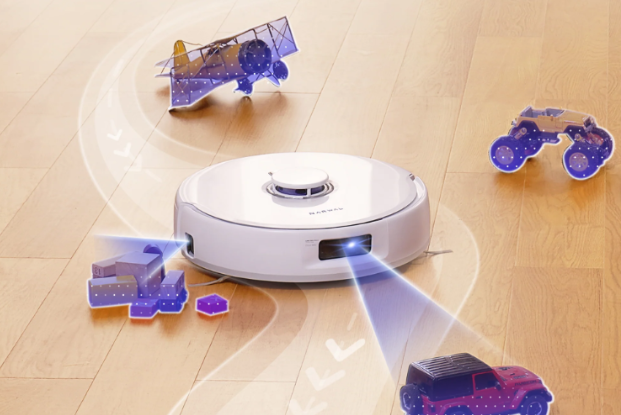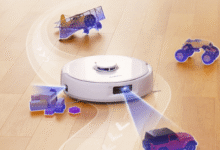Exploring Water Control Technology in Today’s Robot Mops

The Evolution of Robot Mops: Cleaning Floors Autonomously
Maintaining clean floors can be a tedious and time-consuming task. Traditional methods often involve manual scrubbing with mops and buckets, demanding physical effort and regular upkeep. Fortunately, technology offers a solution: robot mops. These automated devices are designed to autonomously clean hard floors, saving you time and energy.
The primary function of robot mops is to provide regular, light cleaning to maintain floors between more intensive manual cleanings. The best models can remove crumbs and dust regularly, making them particularly beneficial for households with children or pets. The emergence of robotic vacuums has transformed the landscape of home cleaning, offering a blend of convenience and technology to keep your floors spotless.
How Robot Mops Work
Robot mops generally employ a combination of sensors, navigation systems, and cleaning mechanisms to achieve their purpose. Sensors help the devices map and navigate your home, avoiding obstacles and ensuring complete coverage. Cleaning mechanisms typically involve mopping pads or rotating brushes that scrub and wipe floors. Water or cleaning solutions are often dispensed to aid in the cleaning process.
Robot Mops: A Modern Cleaning Solution
Robot mops represent a significant advancement in smart cleaning technology. By automating the task of floor cleaning, they provide convenience and free up valuable time for other activities. This technology aligns with the broader trend of home automation, where smart devices are integrated to enhance comfort and efficiency.
Key Features and Technologies in Robot Mops
Advancements in technology have allowed for a wider range of features in today’s cleaning robots.
Navigation and Mapping Systems
Effective navigation is crucial for a robot mop to clean efficiently. Many models use advanced mapping technologies, such as LiDAR (Light Detection and Ranging) or visual Simultaneous Localization and Mapping (vSLAM), to create detailed maps of your home. These systems allow the robot to navigate intelligently, avoid obstacles, and clean methodically.
Mopping Mechanisms
The mopping mechanism is the heart of any robot mop. Common designs include:
- Vibrating Pads: These pads vibrate to scrub the floor, helping to loosen and remove dirt and stains.
- Rotating Brushes: Some models use rotating brushes to agitate the floor surface and sweep away debris.
- Spray Systems: Many robot mops feature spray systems that dispense water or cleaning solution onto the floor, aiding in the cleaning process.
The use of appropriate cleaning solutions can significantly impact cleaning performance. Some robot mops are designed to work with specific cleaning solutions, while others can use plain water. The ability to control the amount of water dispensed is also important, as excessive water can damage certain types of flooring.
Obstacle Avoidance and Carpet Detection
Advanced obstacle avoidance systems allow robot mops to navigate around furniture, pet toys, and other objects on the floor. Carpet detection is another useful feature, enabling the robot to avoid wetting carpets and rugs. Some models can even lift their mopping pads when they detect carpet, allowing them to vacuum and mop in a single cleaning run.
Self-Cleaning and Maintenance Features
Maintaining a robot mop can be time-consuming, so many models now come with self-cleaning features. Some robots can automatically wash and dry their mopping pads, while others have self-emptying dustbins and large water reservoirs that reduce the need for frequent maintenance. These features enhance the convenience of using a robot mop.
Factors to Consider When Purchasing a Robot Mop
Choosing the right robot mop for your home depends on several factors.
Floor Type
Consider the type of flooring in your home. Some models are better suited for hardwood floors, while others excel on tile or laminate. If you have a mix of flooring types, look for a robot mop that can transition seamlessly between surfaces. Softer pads should also be considered to clean wooden floors.
Home Size and Layout
The size and layout of your home will influence the battery life and navigation capabilities you need. If you have a large home, look for a robot mop with a long runtime and advanced mapping features. Multi-story homes may benefit from models that can store multiple floor plans.
Budget
Robot mops range in price from a few hundred dollars to over a thousand. Determine how much you are willing to spend. More expensive models often come with advanced features such as self-cleaning, carpet detection, and smart home integration.
Special Features
Determine which features are important to you. Do you need a robot mop that can vacuum as well as mop? Do you want self-cleaning capabilities? Do you need smart home integration? Make a list of your must-have features and use it to narrow down your options.
The Future of Water Control in Robot Mops
The technology behind water control in robot mops is continually evolving. Future trends may include more precise water dispensing systems, improved stain removal capabilities, and the use of advanced sensors to detect and respond to different types of messes. Integration with smart home systems is also likely to increase, allowing you to control your robot mop with voice commands or through a mobile app.


